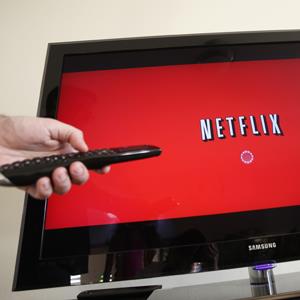It could happen, given the irrationality driving the stock up today, and Apple shares down. But be careful: Netflix's business model remains unsustainable.
Here's all you need to know about Netflix (NFLX +1.97%).
No. 1. The same flavor of irrationality that drives Apple (AAPL +1.48%) down will take NFLX back up to $300.
Go ahead and laugh. But before you do, realize I've called this thing every step of the way:
Timestamp it: NFLX will hit $300 by summer.
Why? Because Reed Hastings has fired up the smoke-and-mirrors machine yet again.
No. 2. Netflix has an excellent product. As somebody who covers the stock and subscribes to the service, there's no question to me that the Netflix of 2013 is worlds better than the Netflix of 2011, from a content standpoint.
As Hastings, the company's chief executive, explains in a fourth-quarter Letter to Shareholders (.pdf file), Netflix has found its content sweet spot. It owns KidsTV. It has become an excellent outlet for prior seasons of current television shows (e.g., "Mad Men"). It's about to roll the dice on original programming. And you'll be hard-pressed to find its most popular movies and television shows on competing services such as Hulu and Amazon (AMZN -2.12%) Prime.
That's all good, but it's simply not going to fly as a business at $8 per month.
Once again, cash is getting tight
The "virtuous cycle" Hastings touts (more subscribers means more money for content, more money for content means more subscribers, and so on) is actually a "vicious cycle." Always has been. Its errant deal with Walt Disney (DIS -0.55%) notwithstanding, content owners will not license premium content if Netflix continues to give it away, all you can eat, at $7.99 a month.
In the past, we have managed our content licensing agreements such that cash payments in any quarter do not exceed 110% of the P&L expense (in other words, if our P&L expense was $200 million in the quarter, our cash payments for content would not exceed $220 million in the quarter). As we shared on our last earnings call, our original programming will require more up-front cash payments than most other content licensing agreements, raising this ratio (of cash to P&L for content) to as high as 120% in certain quarters with material originals payments. The bulk of our remaining cash payments for our current originals will be in Q1, driving FCF materially more negative than Q4, and then FCF will improve substantially in subsequent quarters.
So free cash flow is plummeting. Spending continues to escalate. And cash is, once again, getting tight:
In addition, we are exploring taking advantage of the current low interest rate environment to refinance our $200 million in outstanding notes and raise additional cash through new debt financing. This would give us additional reserves as well as increased flexibility to fund future originals.
After Netflix raised cash at the end of 2011, it had $508 million in cash and cash equivalents. That was up from $160 million in the previous quarter. The big jump came because Netflix raised funds in a pair of dilutive financing deals. At the end of 2012, that cash number continued to trend lower, down to $290 million. (Data from the company's fourth-quarter financial statements, available on the Netflix investor relations website).
Because, I'm telling you, Netflix would have been in the cash crunch it refuses to call a cash crunch (it did the same thing at the end of 2011) with or without original programming. Traditional content acquisition and international expansion does a fine job of burning the company's cash.
So proceed with extreme caution. At the same time that so much has changed for the better at Netflix, the same toxic ingredients that render its business unsustainable remain.
 By
By 
Now here is a stock thats had a ride alright. The stock trsded for just three dollars a share in 2003 today the shares trade around 100 and just six months ago or so the stock traded as high as 250.
ReplyDelete